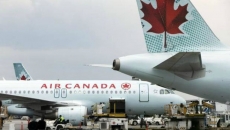BRACEBRIDGE, Ont. - Cpl. Nathan Cirillo wasn't the only fallen Canadian honoured Tuesday.
Seven decades after their deaths, a solemn two minutes of silence was observed for two airmen at the place where their plane went down — in the middle of picturesque Lake Muskoka.
Their Northrop A-17 Nomad aircraft collided in-flight with a similar plane on Dec. 13, 1940 — about a year into the Second World War — while on a search mission for an airman who had gone missing.
The other plane was located shortly after the crash; both men on board were killed. But the Nomad carrying 24-year-old pilot Peter Campbell and 27-year-old observer Theodore Bates would not be found for almost 70 years.
In November 2007, a campaign was launched by the Royal Canadian Legion and the Lost Airmen of Muskoka Project to comb Lake Muskoka for the plane. The Nomad was finally discovered in July 2010 by Ontario Provincial Police divers, who also identified personal effects belonging to Campbell and Bates.
Their remains were recovered by a Royal Canadian Navy team in October 2012 and they were honoured in an interment ceremony.
On Tuesday, rusted wreckage from the downed warplane — a wheel and the tail section — was hoisted to the surface by a crane attached to a large truck on a barge.
Royal Canadian Air Force Maj. Jan Kennedy said the fact the recovery mission was happening at the same time as the funeral for Cirillo in Hamilton made the day all the more poignant.
"It's been an extremely emotional day today, with the recovery of the tail ... it drives home the story of the two people who perished here. And to have that occur on the day of the funeral is unbelievable," Kennedy said.
She called the 1940 crash "a heartbreaking story."
Bates had just received his pilot's wings the day before the crash and was given the day off. But after hearing that a fellow airman had gone missing, he volunteered to help in the search.
"He didn't even have time to sew his wings onto his uniform, he tucked them into his pocket," Kennedy said.
"The weather was terrible and he ended up in a mid-air collision."
If all goes according to plan, the Royal Canadian Air Force hopes the main fuselage of the plane will be moved out of the water by Sunday. It is set to be transported to the National Air Force Museum of Canada in Trenton, Ont.
"It is the only Nomad aircraft that will be on display in Canada and only one of two on display in all of North America," Kennedy said.
Royal Canadian Navy Lt.-Cmdr. Stephan Julien said it was crucial that the remains of Campbell and Bates be recovered, as well as their plane.
"This aircraft is part of our Canadian history, it's part of our heritage, so it was really important we brought it back to the surface for the Canadian population to see that we don't abandon our brothers and sisters no matter where they are," he said.





